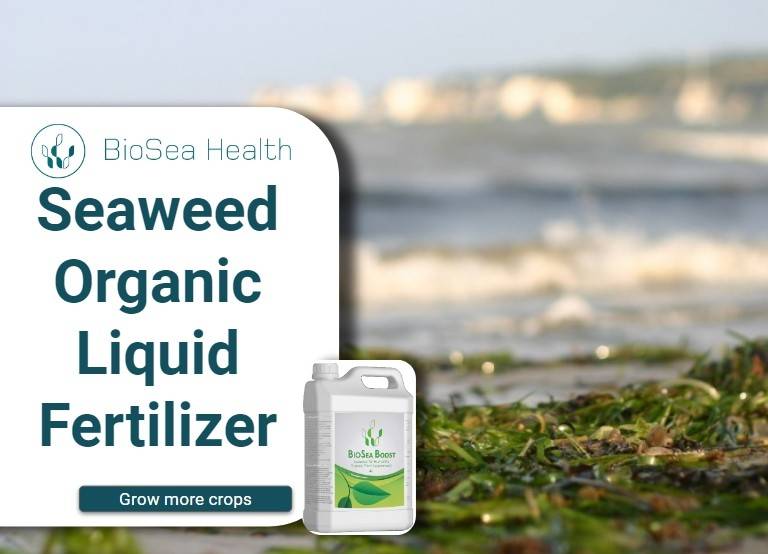Seaweed is a great source of nutrients and plant growth regulators for use in plant biostimulants. Natural, organic
Organic Fertilizers – Plant Biostimulants
Organic fertilizers contain some plant biostimulants. Plant biostimulants are substances or microorganism applied to plant to improve nutrition, abiotic tolerance to stress, and crop quality irrespective of the amount of available soil nutrients. Biostimulants may include biological fertilizers such as liquid seaweed extract and liquid fish fertilizers, which enhance the supply of nutrients to plant. Biostimulants also include microbial fungi and bacteria. These are mycorrhizal fungi, non-mycorrhizal fungi, rhizobium, and Plant Growth-Promoting Rhizobacteria (PGBR). Therefore, microorganisms applied to plants may have a dual physiological function acting as biological control agents and bio-stimulant.
Biostimulants contain the right amount of plant growth-promoting hormones such as auxin, gibberellin, cytokinin, ethylene, and abscisic acid. Biostimulant is described as any substance useful for plant growth and development other than pesticides, fertilizers or organic soil amendments.
Several biostimulants are summarized into groups based on their taxonomy and classification. They exist in different formulations but are grouped into categories based on their origin and components. These include:
1. Humic substances
Humic substances are natural components of the soil organic substance derived from the disintegration of animal, plant, and microbial wastes. Humic substances are heterogeneous compounds classified into humin, humic and fulvic acid based on molecular weight and solubility. These compounds also exhibit a complex process of breaking down into molecular colloids, caused by the stimulus of plant roots through the exudation of protons. Humic substances called humates are produced from the symbiosis relationship which occurs between organic matter, microbes, and plant roots. They stimulate growth when applied to plant roots.
2. Protein hydrolysates and other compounds
containing nitrogen N
Amino acids and peptide mixtures are produced from the chemical and enzymatic hydrolysis of protein from agro by-products of both plant and animal origin. These compounds functions as biostimulants for plant growth and development. Glycine-betaine is an excellent example of amino acid derivatives with anti-stress properties. The direct effects of protein hydrolysates on plants include assimilation of nitrogen and regulation of enzymes involved in the uptake of nitrogen. Some amino acids, such as proline are engaged in the process of chelation that can protect plants from heavy metal toxins. They also contribute to the mobility of fixed soil micronutrients.
3. Organic fertilizers from Seaweed
Fresh sea algae is a good source of organic matter, and its liquid extract is used as biostimulant fertilizer to enhance plant growth. Algae extracts and purified compounds are now being produced for commercial use. The active ingredients include micro and macroorganisms, sterols, N- containing compounds such as betaine and hormones. These compounds are unique in their source of algal, which relates to the expanding interests of researchers and industries in the use of algae for plant growth. The majority of the algal species belong to the phylum of brown algae – Ascophyllum, Fucus, Laminaria as the main genera, but carrageenans take its origin from red algae.
Hormones such as cytokines and gibberellic acid are components of algae extracts useful for growth stimulation in plants. Cytokine hormone improves nutrient uptake in plant leaves for higher chlorophyll content which aids photosynthesis. Gibberellins with gibbrane structures function in stem elongation, parthenocarpy, bolting and flowering. Breaking of seed dominance is also achieved when seeds are soaked in seaweed extracts before planting.
4. Inorganic compounds
Some beneficial elements, such as Aluminum, Cobalt, Sodium, Selenium, and Silicon, are present in the soil as mineral salts and as insoluble structures like amorphous silica in graminaceous species. The effects of these beneficial elements include rigidification of the cell wall, osmoregulation, heat control through radiation reflection and enzymatic action, protection against toxicity of heavy metals, and synthesis of plant hormone. Inorganic salts of these beneficial elements – chlorides, silicates, phosphates, phosphites, and carbonates have been utilized as fungicides.
5. Fungi and bacteria beneficial microbes
Diverse relationships exist between plant roots and fungi such as mutual symbiosis and parasitism. The mycorrhizal are a heterogeneous group of fungi that establish a mutually benefiting relationship with more than 90% of all plant species. The Arbuscular Mycorrhiza Fungi (AMF) are formed from the penetration of hyphae fungus from species of Glomeromycota into the cortical roots to form branched structures called arbuscules. Mycorrhiza fungi are being used to induce growth through a symbiotic process for nutritional efficiency as well as plant protection from biotic and abiotic stress.
Bacteria induce physiological growth in a plant through the supply of nutrients, resistance to disease, improvement of abiotic compounds, tolerance to stress, and modulation of morphogenesis.
The global market for organic fertilizers or plant biostimulants is increasing, and Biosea Boost is a natural organic certified fertilizer in the Philippines.
References
Agricen. (n.d.). Agriculture Biostimulants: Crop Production: Plant Health. Retrieved from http://www.agricen.com/agricultural-biostimulants
Brown, P., & Saa, S. (2015). Biostimulants in agriculture. Frontiers in Plant Science, 6. doi: 10.3389/fpls.2015.00671
Kauffman G. L., III, Kneivel D. P., Watschke T. L. (2007). Effects of a biostimulant on the heat tolerance associated with photosynthetic capacity, membrane thermostability, and polyphenol production of perennial ryegrass. Crop Sci. 47 261–267 10.2135/cropsci2006.03.0171
Plant biostimulants – ScienceDirect.com.” 30 Nov. 2015, https://www.sciencedirect.com/science/article/pii/S0304423815301850.
Yakhin, O. I., Lubyanov, A. A., Yakhin, I. A., & Brown, P. H. (2017). Biostimulants in Plant Science: A Global Perspective. Frontiers in Plant Science, 7. doi: 10.3389/fpls.2016.02049

